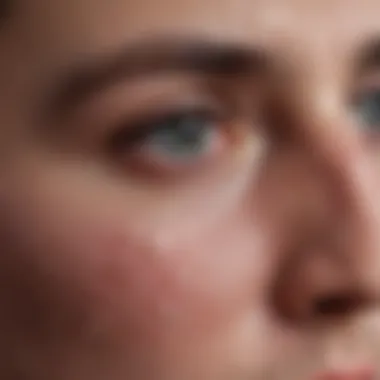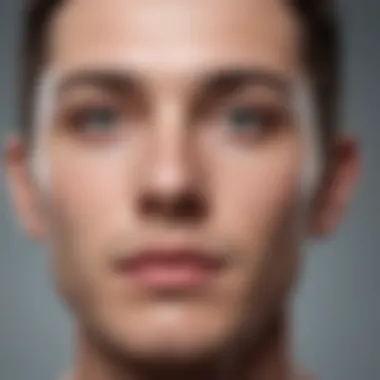Top Strategies for Effective Blackhead Treatment


Intro
Understanding Blackheads
Before diving into treatment methods, it is essential to understand what blackheads are and how they develop. Blackheads are a form of acne, specifically an open comedone. Unlike whiteheads, which are closed at the surface, blackheads remain open, which allows oxidation to occur. This leads to the dark appearance that defines blackheads.
Several factors contribute to their development:
- Excess oil production
- Accumulation of dead skin cells
- Bacteria on the skin
- Hormonal fluctuations
By examining these factors, individuals can better comprehend their skin and choose suitable treatments to address blackheads effectively.
Professional Treatments for Blackheads
If over-the-counter solutions have not worked or if the blackheads are particularly stubborn, consulting a dermatologist may be beneficial. Several professional treatments exist that have shown effectiveness:
Chemical Peels
Chemical peels involve applying a solution to the skin that causes it to exfoliate. This process allows for the removal of dead skin layers, unclogging pores in the process. Different types of acids can be used, such as salicylic acid or glycolic acid, both known for their pore-cleansing properties.
Microdermabrasion
Microdermabrasion is a non-invasive treatment that exfoliates the skin using tiny crystals. This technique helps reduce blackheads and improves overall skin texture. It can be especially appealing for those seeking immediate results with minimal downtime.
Extraction
A trained professional can perform an extraction to remove blackheads manually. This method should be done with care to prevent skin damage or irritation. Proper extraction can be effective for immediate results but is often followed by other treatments for long-term benefits.
At-Home Solutions for Blackheads
In addition to professional treatments, several at-home methods can help in managing and preventing blackheads:
Salicylic Acid Cleanser
Using a cleanser containing salicylic acid can help disrupt the buildup of oils and skin debris. Regular use can lead to fewer blackheads over time.
Clay Masks
Clay masks work by drawing out impurities and excess oil from the skin. Incorporating these into your skincare routine once a week can yield noticeable improvements in the clarity of the skin.
Exfoliation
Gently exfoliating the skin a few times a week helps remove dead skin cells, which can decrease the chances of clogged pores. Look for exfoliants with gentle ingredients to avoid irritating the skin.
Prevention Strategies
Preventing blackheads is equally vital to treatment. Implementing good skin care habits and lifestyle choices can significantly reduce their occurrence:
- Regular cleansing: Keep the skin clean to remove oil and debris.
- Moisturize appropriately: Use non-comedogenic moisturizers that do not clog pores.
- Avoid heavy makeup: If makeup is worn, ensure that it is non-comedogenic.
"Prevention is often the most effective cure—keeping skin clean and maintaining a consistent skincare routine can significantly reduce blackheads."
End
Blackheads, though a common skin concern, can be effectively managed through a combination of professional treatments and diligent at-home care. Understanding the science of blackhead formation is crucial in selecting the right methods tailored to individual skin types. By adhering to recommended strategies and incorporating the right products, one can look forward to clearer, healthier skin.
Understanding Blackheads
Blackheads are a common skin concern, yet their persistence often leads to misunderstanding. The importance of understanding blackheads cannot be overstated in achieving effective treatment. An informed approach involves knowing what they are, what causes them to form, and how various skin types react to them. This foundational knowledge allows individuals to select appropriate treatments, preventing further irritation or skin issues.
Blackheads are the result of clogged hair follicles in the skin, filled with sebum and dead skin cells. Unlike other types of acne, they are not painful or inflamed but can impact one's aesthetic appeal. Understanding the formation process is key in preventing and managing them effectively. Additionally, not all skin types are the same, and strategies may need to be tailored accordingly.
What are Blackheads?
Blackheads are a type of acne known as open comedones. They appear as small dark spots on the surface of the skin, commonly found on the nose, forehead, and chin. The oxidation of melanin in the clogged pores is what gives them their dark color.
These blemishes are often mistaken for dirt, but they are not caused by poor hygiene. Instead, they emerge when excess oil and cellular debris accumulate in the hair follicle. Although they do not cause inflammation, their presence can affect self-esteem and confidence, highlighting the need for effective treatment.
Causes of Blackhead Formation
Several factors can contribute to the formation of blackheads.


- Excess Sebum Production: Oily skin is often a primary culprit due to its ability to produce more sebum.
- Dead Skin Cells: When skin cells do not shed properly, they can build up and mix with oil, leading to clogged pores.
- Hormonal Changes: Fluctuations during puberty, menstruation, or pregnancy may increase oil production, making blackheads more likely.
- Diet and Lifestyle: High sugar and high-fat diets have been linked to acne. Stress can also play a role by triggering hormonal imbalances.
Awareness of these causes can empower individuals to make informed lifestyle choices, contributing to better skin health.
Skin Types and Blackheads
Understanding how different skin types interact with blackheads is crucial for effective treatment.
- Oily Skin: People with this skin type are more prone to blackheads due to the overproduction of sebum. Regular cleansing can help manage oil levels.
- Dry Skin: While less common, dry skin can also develop blackheads when dead skin cells accumulate. Lightweight exfoliation may be needed to prevent this.
- Combination Skin: This skin type often reflects characteristics of both oily and dry skin, which means targeted treatments may be necessary.
- Sensitive Skin: Those with sensitive skin should be cautious, as certain treatments may lead to irritation.
In summary, understanding blackheads fosters better treatment choices. By comprehending what blackheads are, recognizing their causes, and acknowledging how skin types influence their presence, individuals can take proactive steps toward effective management.
Professional Treatments for Blackheads
Professional treatments for blackheads represent a pivotal facet of managing this frequent skin condition. Such treatments provide options that often surpass the capabilities of standard at-home remedies. This article delves into various professional methods, outlining their specific elements and benefits, as well as considerations that must be taken into account when assessing which option may be appropriate.
Chemical Peels
Chemical peels involve the application of acidic solutions to the skin, which helps to exfoliate and remove dead skin cells. They play a significant role in treating blackheads by unclogging pores. The process promotes cell turnover, leading to smoother and clearer skin over time. It is essential to choose the right type of peel according to your skin sensitivity and condition.
Common acids used in peels include glycolic and salicylic acid. These not only remove existing blackheads but also prevent the development of new ones.
Microdermabrasion
Microdermabrasion is another effective treatment. This technique uses fine crystals to lightly exfoliate the skin, enabling the removal of the top layer of dead cells. The procedure enhances skin texture and appearance. Individuals seeking a non-invasive option frequently choose this method.
Such treatments can be tailored to individual needs. However, regular sessions may be necessary to maintain results. The recovery time is typically minimal, making it a popular choice for many.
Extraction Techniques
Extraction techniques are aimed at physically removing the blackhead from the pore. This category encompasses various methods, each with its unique features and benefits.
Manual Extraction
Manual extraction involves a professional using specialized tools to extract impurities from the skin. This technique is precise and allows the professional to remove blackheads effectively. Many prefer this method due to its direct approach; however, it does carry some risks such as irritation or scarring if not done properly.
One key characteristic of manual extraction is that it can be performed in tandem with other treatments like chemical peels or facials. It can also provide immediate results, which is often seen as a large benefit.
Vacuum Extraction
Vacuum extraction differs from manual methods as it utilizes suction to remove blackheads. This method is typically less invasive and has lesser recovery time. It provides a quick and often painless way to clear clogged pores.
However, one should consider the unique feature of vacuum extraction; while it is effective, it may not work for all skin types. Those with sensitive skin might find this method less suitable. Therefore, careful assessment by a skincare professional is recommended.
Laser Treatments
Laser treatments employ focused light to target various skin concerns, including blackheads. These treatments work by reducing oil production and killing bacteria that cause acne. Laser therapies can provide long-lasting results, making them an enticing option for individuals looking for a more permanent solution.
It is crucial, however, to consult with a qualified dermatologist to discuss the appropriate laser type based on specific skin needs.
"When it comes to professional treatments, it’s important to remember that the effectiveness might vary based on individual skin types and conditions."
Understanding what each treatment entails can empower individuals to make informed decisions regarding their skincare regimen. When weighing options, keep in mind your skin’s unique requirements and consult a professional for personalized guidance.
At-Home Remedies and Over-the-Counter Solutions
Dealing with blackheads can be frustrating. Many people prefer to tackle this issue in their own homes before seeking professional help. At-home remedies and over-the-counter solutions are not only accessible but can also be effective for many individuals. Understanding various methods and products available can help in making informed choices tailored to specific skin needs.
BHA and AHA Products
Beta Hydroxy Acid (BHA) and Alpha Hydroxy Acid (AHA) are popular options in skin care routines focused on treating blackheads.
- BHA, specifically salicylic acid, penetrates deep into pores to exfoliate the inner lining. It is oil-soluble, making it ideal for oily skin.
- AHA, like glycolic acid, works on the surface level to enhance skin texture and brightness, promoting cell turnover.
Using products with these acids can help unclog pores and reduce blackheads. When incorporating these, it is prudent to start with a lower concentration to assess skin tolerance. Overuse may lead to irritation.
Clay Masks
Clay masks serve a dual purpose of cleansing and detoxifying the skin. They absorb excess oil and draw out impurities from the pores, making them effective for blackhead treatment.
- Bentonite Clay or Kaolin Clay can be especially effective for oily skin types. These clays help in removing toxins that contribute to blackhead formation.
- Regular use of clay masks can lead to improved skin texture over time.


However, it is essential to not overdo these masks, as excessive drying can trigger the skin to produce even more oil.
Pore Strips: Benefits and Limitations
Pore strips are a quick and convenient solution for many individuals. They temporarily remove build-up from pores and can provide an immediate sense of cleanliness.
Benefits:
- Instant results in removing blackheads.
- Easy to use and can be found in most drugstores.
Limitations:
- They do not prevent future blackheads.
- Overuse can lead to skin irritation or damage to the upper layer of skin.
Relying solely on pore strips may not lead to long-term effectiveness; they should be used in conjunction with other treatments.
Salicylic Acid Treatments
Salicylic acid is a go-to treatment for many acne-related issues, including blackheads. This beta hydroxy acid has anti-inflammatory properties and exfoliates the skin, helping in unclogging pores.
Salicylic acid is available in various forms, including:
- Cleansers
- Spot treatments
- Toners
- Lotions
Using salicylic acid regularly can maintain clearer skin. It is advisable to follow product instructions closely to avoid irritation.
Retinoids for Blackhead Management
Retinoids are known for their effectiveness in promoting cellular turnover and helping with blackhead management. Products like retinol can encourage deeper skin exfoliation and prevent clogged pores.
While retinoids can be very effective, users should be mindful of potential irritation, especially in sensitive skin types. Starting slow and applying products in lower concentrations can allow the skin to adjust effectively.
For more information on blackhead treatments, visit Wikipedia or Britannica.
Preventative Measures
Preventative measures play a crucial role in managing blackheads and reducing their occurrence. Often, prevention is more effective than treatment after the fact. By adopting certain habits and practices, individuals can minimize the likelihood of blackhead formation on their skin.
Daily Cleansing Routines
A consistent cleansing routine is vital for maintaining clear skin. It helps remove excess oil, dirt, and dead skin cells that can clog pores. Using a gentle cleanser twice a day can promote skin health without stripping natural oils. Look for products containing salicylic acid, as they not only cleanse but also help prevent clogged pores.
Proper technique is essential. Start by wetting the face with lukewarm water, apply the cleanser in circular motions, and rinse thoroughly. Avoid harsh scrubs, as they can irritate skin and worsen blackhead formation.
Moisturizing Techniques
Moisturizing is often overlooked in the fight against blackheads, yet it is key to maintaining balance. Skin that is too dry can overproduce oil, leading to clogged pores. A lightweight, oil-free moisturizer is ideal for those prone to blackheads. This keeps skin hydrated without adding excess oil.
Applying moisturizer immediately after cleansing ensures that your skin retains moisture, creating an effective barrier against contaminants and impurities.
Choosing Non-Comedogenic Products
Selecting non-comedogenic products is essential in preventing blackheads. These products are designed not to clog pores, reducing the chances of oil buildup. Look for labels indicating non-comedogenic status when opting for face wash, sunscreen, and cosmetics.
Some ingredients to consider include:
- Glycerin
- Hyaluronic Acid
- Dimethicone
On the other hand, steer clear of heavy oils and certain fragrances that are known to obstruct pores. Always check skincare labels and, when in doubt, choose products that suit your specific skin type.
"Prevention is better than cure." Adopting these strategies not only aids in managing blackheads, it also promotes overall skin health.
Understanding Skin Care Labels
Understanding skin care labels is essential when it comes to managing blackheads effectively. The products we choose to apply to our skin often contain a blend of various ingredients, each designed to serve specific purposes. A critical evaluation of these elements can help tailoring a regimen that promotes clear skin and enhances overall appearance.
When shopping for skin care products, understanding labels is not just about reading the name of the product. It involves recognizing effective active ingredients and possible irritants. This can greatly help in making informed decisions, preventing further skin issues, and maximizing treatment benefits.
Active Ingredients to Look For
Active ingredients are the key players in any skincare product. When it comes to treating blackheads, certain ingredients are particularly effective. Here are some important ones to consider:


- Salicylic Acid: This beta hydroxy acid penetrates deep into the pores, helping to dissolve the oil and dead skin that lead to blackhead formation. It also has anti-inflammatory properties that can help lessen redness.
- Glycolic Acid: An alpha hydroxy acid that exfoliates the surface of the skin. It accelerates cell turnover, removing dead skin cells that could clog pores.
- Benzoyl Peroxide: Known for its antibacterial properties, this ingredient can help prevent acne and improve skin clarity by reducing the bacteria that can contribute to blackhead formation.
- Retinoids: These compounds, derived from Vitamin A, promote cell turnover and prevent clogged pores. They are effective in managing not just blackheads, but overall skin texture.
Looking for products that contain these active ingredients can lead to promising results in your blackhead treatment regimen.
Ingredients to Avoid
While some ingredients can be beneficial, others can exacerbate skin concerns or cause new issues. It is crucial to avoid:
- Mineral Oil: Often used in moisturizers, it can clog pores and lead to more blackheads.
- Fragrance: At times added for scent, fragrance can irritate the skin and lead to inflammation, worsening skin conditions.
- Alcohol: High concentrations of alcohol can dry out the skin, leading to irritation, which might trigger excess oil production as the skin tries to compensate.
- Silicones: These can create a barrier that traps sebum and dead skin cells in pores, exacerbating blackheads.
By steering clear of these ingredients, you can maintain a suitable environment for skin health.
"Knowledge of skin care labels can empower consumers in selecting products that work effectively."
In summary, understanding skin care labels is a vital part of effective blackhead management. By knowing which active ingredients to seek and which to avoid, individuals can create a skincare routine that promotes clearer skin while minimizing the risk of further issues.
Consulting a Dermatologist
Consulting a dermatologist is often essential for individuals dealing with persistent blackheads and related skin issues. A dermatologist specializes in skin health and is equipped with the knowledge and tools necessary to address complicated skin conditions. This consultation is not just about seeking a solution; it also involves understanding skin health from a holistic perspective. By consulting a professional, one can receive personalized advice, thereby ensuring that treatments align with specific skin needs.
It is important to note that not all blackhead treatments are the same. Some methods might aggravate certain skin types while helping others. A dermatologist can conduct a thorough evaluation, determine the underlying causes, and recommend appropriate interventions. This tailored approach fosters a more effective treatment journey and minimizes the risk of side effects. It also serves to educate patients about their skin, leading to better long-term management choices.
"Skin health is not merely cosmetic; it’s crucial for overall well-being. Seeking professional guidance can significantly enhance the efficacy of your skincare routine."
Skin issues can sometimes signal deeper concerns, such as hormonal imbalances or allergies. A dermatologist can investigate these factors, enabling individuals to tackle blackheads with a comprehensive treatment plan that goes beyond superficial solutions. This level of care often proves invaluable.
When to Seek Professional Help
It can be challenging to know when to consult a dermatologist concerning blackheads. Here are some indicators:
- Persistent Blackheads: If blackheads remain despite following a consistent skincare routine.
- Severe Breakouts: Occurrence of inflamed acne or pimples along with blackheads.
- Skin Irritation: Signs of redness, swelling, or increasingly sensitive skin.
- Changes in Skin Texture: Any noticeable changes in skin surface or condition.
- Concerns About Scarring: If there is a risk of scarring or post-inflammatory marks from attempts to extract blackheads yourself.
Knowing the right time to seek help can lead to quicker and more effective treatment solutions.
Questions to Ask Your Dermatologist
When you decide to consult a dermatologist, being prepared with pertinent questions can maximize the value of your appointment. Consider asking:
- What are the underlying causes of my blackheads? This helps you understand the root issue and informs treatment methods.
- Which treatments are best suited for my skin type? Personalized advice is key; what works for others may not work for you.
- Are there specific skincare products I should avoid? Certain ingredients can worsen blackheads or other conditions.
- How often should I follow up for treatment? Understanding the treatment frequency can set realistic expectations.
- What lifestyle changes might help reduce blackheads? These could include diet, hydration, or stress management tips.
Asking thoughtful questions enables a productive dialogue and fosters a deeper understanding of skin health.
Consulting a dermatologist can significantly impact one’s journey toward clearer skin. Their expertise shines a light on effective and safe approaches tailored to individual skin concerns. Embracing such a proactive attitude will yield beneficial results in the long run.
Realistic Expectations and Skin Care
Understanding realistic expectations regarding blackhead treatment is vital for anyone dealing with this common skin condition. Many individuals seek quick and effortless solutions, often resulting in disappointment. It's important to recognize that complete elimination of blackheads may not be feasible for all skin types. Rather, an effective approach involves managing and minimizing their appearance over time.
Understanding Treatment Limitations
Each treatment option comes with its own set of limitations. For instance, over-the-counter products like salicylic acid can effectively reduce blackhead visibility but may take several weeks to show significant improvement. Patients often underestimate the time necessary for products to work. Additionally, some treatments, particularly stronger chemical solutions, can cause irritation if used excessively. This highlights the need for a balanced approach, utilizing products designed for one's specific skin type and conditions.
"Effective skin care comes down to consistent routines and realistic assessments of treatment outcomes."
Another limitation lies in the variability of skin types. Not all products have the same effect on everyone. Therefore, it is important to recognize one’s unique skin characteristics and seek personalized solutions whenever possible. Understanding that a single approach may not universally work can help in adjusting expectations for treatment outcomes.
Long-term Skin Management Strategies
To achieve long-lasting results, consider integrating several strategies into your skincare routine. Firstly, maintain a consistent cleansing routine to keep pores clear. Gentle cleansers that contain active ingredients such as glycolic acid or salicylic acid can prevent the buildup of dead skin and other impurities.
Additionally, incorporating retinoids into your regimen can enhance skin cell turnover, decreasing the likelihood of new blackheads forming. These products are typically more effective when used regularly over extended periods.
It is also crucial to adopt healthy lifestyle habits that promote overall skin health. Staying hydrated, eating a balanced diet rich in vitamins and antioxidants, and avoiding smoking can contribute positively to skin condition.
Regular check-ins with a dermatologist should not be overlooked. Professional guidance can provide tailored strategies specific to individual needs, helping to refine treatments as necessary. Careful observation of skin changes over time will allow for adjustments in one’s approach.
In summary, managing blackheads is a process that requires patience, realistic expectations, and a broad strategy tailored to individual skin types. Recognizing the limitations of treatments available and developing long-term management practices can significantly improve skin health and appearance.
Ending
Addressing blackheads effectively is essential for several reasons, particularly for those who prioritize their skin's appearance. This common skin issue can affect anyone, regardless of gender, and its persistent nature often leads to frustration. Understanding the various treatment options discussed in this article is crucial for formulating a personal approach that works best for your skin type.
A key takeaway is the importance of recognizing that no single treatment will universally resolve blackheads for everyone. Skin types and conditions vary widely, which necessitates a tailored strategy. Professional methods, such as chemical peels and microdermabrasion, or at-home solutions like salicylic acid treatments, provide options that can be effective based on individual needs.
Additionally, prevention should remain a priority. Developing daily cleansing routines, choosing non-comedogenic products, and understanding skin care labels can all contribute significantly to minimizing future occurrences of blackheads. By focusing on a comprehensive skin care strategy, individuals canbetter manage not only blackheads but also overall skin health.
Ultimately, this article empowers readers with the knowledge to make informed decisions about their skincare. Remember, while it can take time and experimentation to find the right approach, the benefits of clear, healthy skin are well worth the effort. As the skin continuously evolves, consistent attention to care is essential in maintaining its appearance. Regular consultations with a dermatologist can further enhance skin management strategies, ensuring that any concerns are professionally addressed. > "Success in skin care is not just about treatment; it’s about understanding and management."















